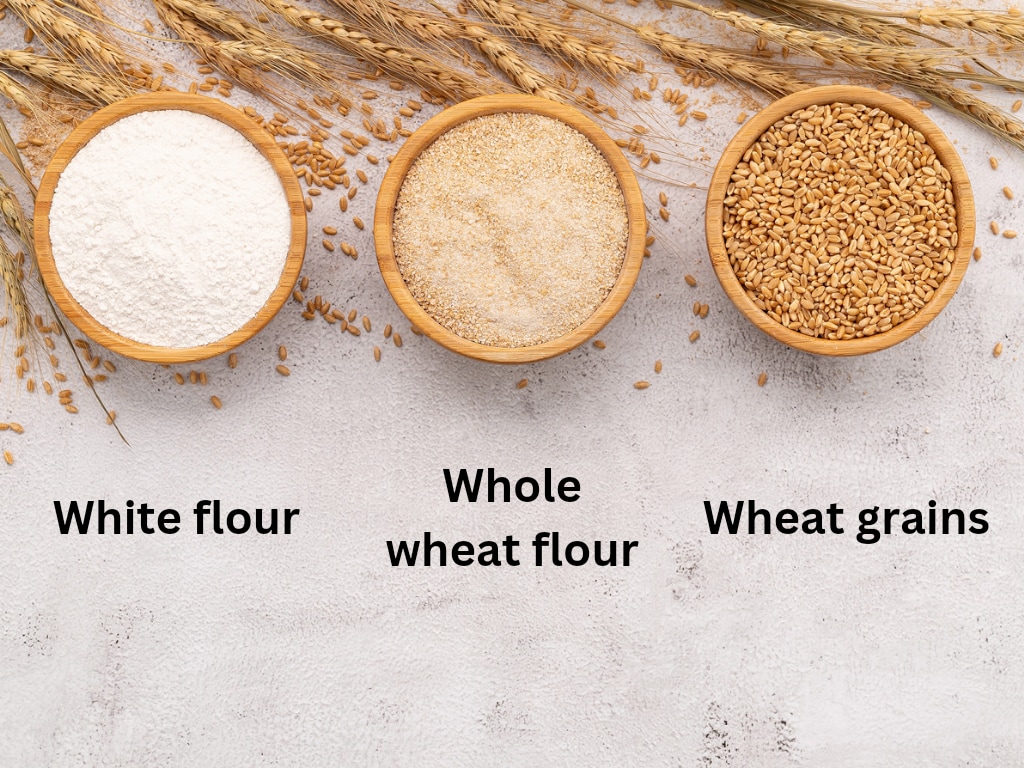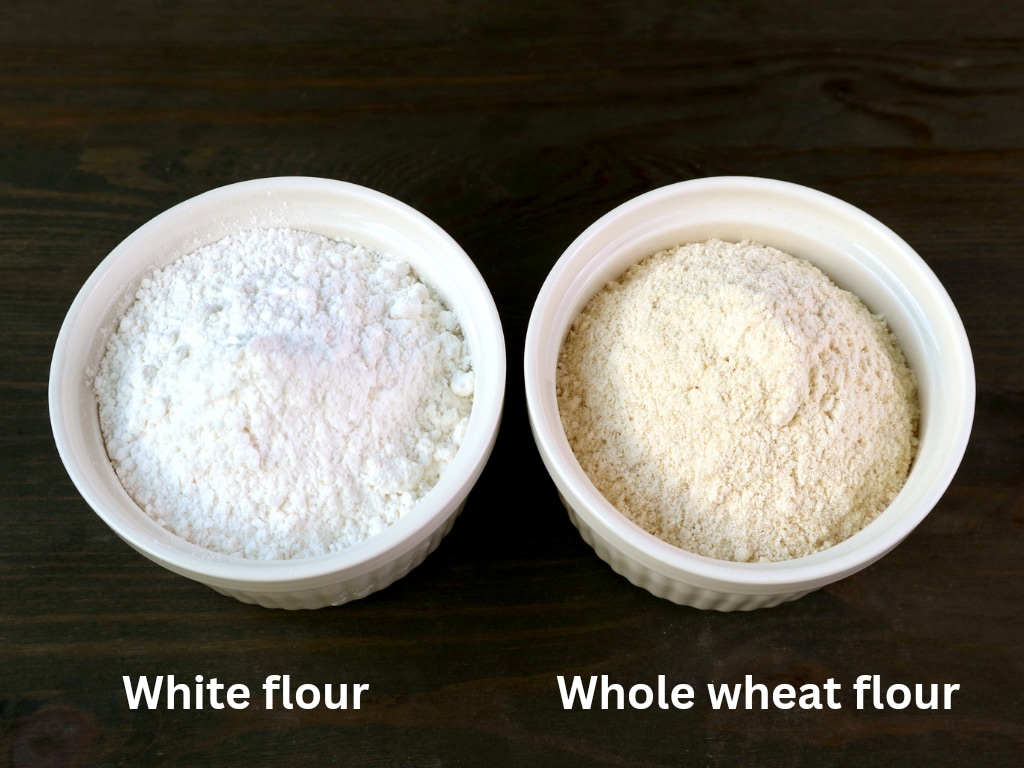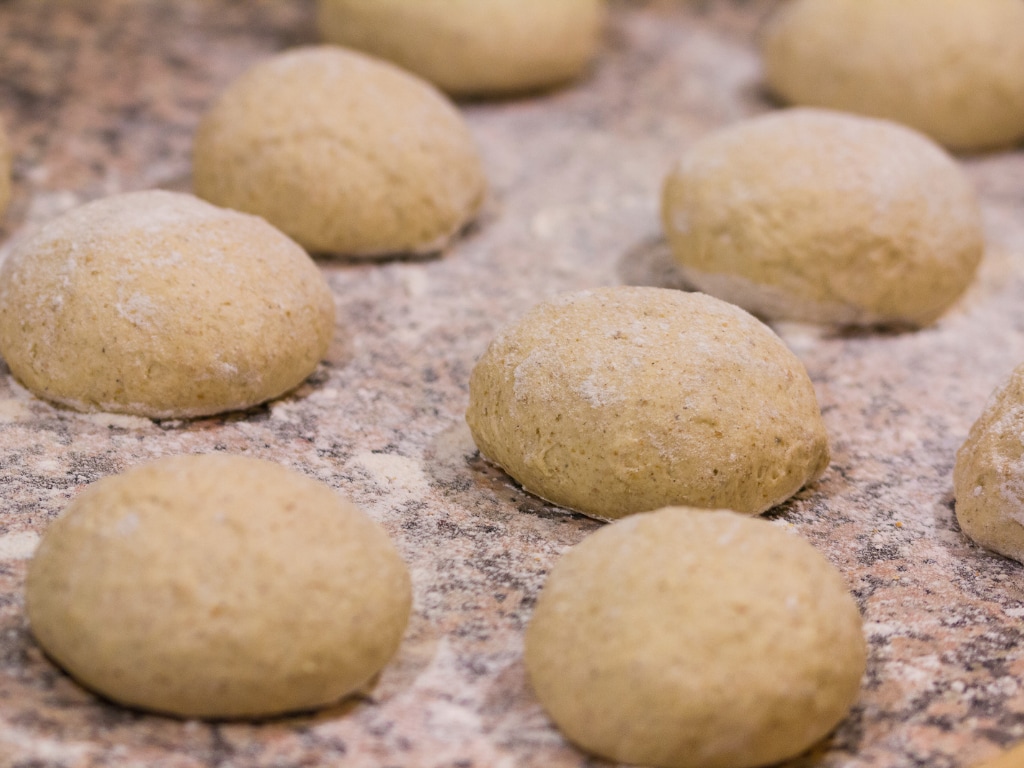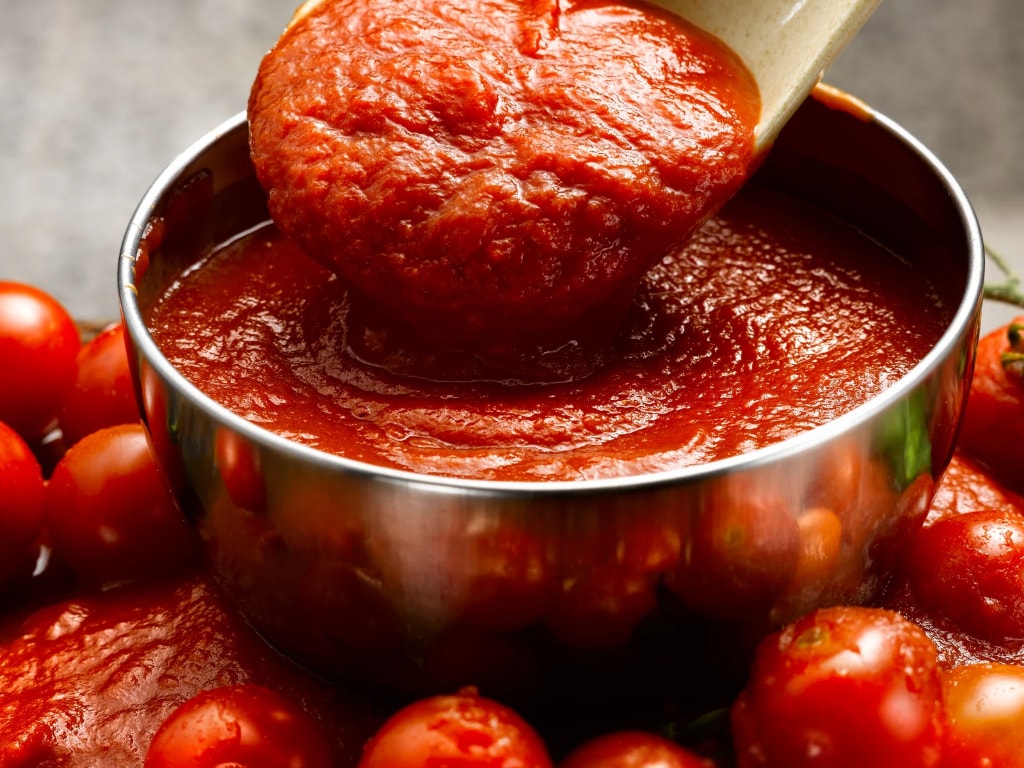100% Whole Wheat Pizza – Healthy Pizza Crust
Whole wheat pizza crust has a negative reputation since it is usually dense and crumbly. Whole wheat yeasted dough cannot rise to the same level as white flour dough.
For this reason, I developed a 100% whole wheat pizza dough that not only rises perfectly but is also soft and flavorful. If you are looking for a healthy but delicious alternative to all-purpose flour pizza, you'll love this pizza dough!
This pizza crust recipe is super rich in many nutrients, such as multiple B group vitamins, vitamin E, and minerals including selenium, manganese, magnesium, phosphorus, iron, zinc, and copper.
What is the difference between all-purpose flour and whole-wheat flour?
All-purpose flour, also called white flour is made from the endosperm after the bran (the outer layer of the wheat kernel) and germ (a portion of the inner seed) are removed.
All-purpose flour has a lower nutritional value because it does not contain all portions of the grain (it only contains the endosperm of the wheat grain). It may also contain a variety of chemicals that were introduced during the bleaching process.
All of the hard red wheat berries are ground into flour to make whole wheat flour, which is higher in nutrients and has a darker color because of the bran and wheat germ.

Whole wheat flour contains more protein than all-purpose flour and is higher in fiber, nutrients, and flavor.
However, whole wheat flour has a bad reputation for making baked goods dense and stodgy because the bran and germ prevent gluten from forming.

Why is whole wheat flour healthier?
The short answer is that whole wheat flour has more nutritional value than white flour.
The long answer is:
Whole wheat flour contains more fiber and protein.
Despite having almost the same amount of calories and carbohydrates as white flour, whole wheat flour has much more protein, fat, and fiber.
Whole wheat flour has approximately 30% more protein, making it the greatest option for bodybuilders looking to increase their protein intake.
However, because whole wheat flour has more fiber than all-purpose flour, it is less filling. Therefore, it isn’t the best option for someone who is struggling to consume enough calories.
The fiber content of whole wheat flour helps stabilize blood sugar when consuming sugary pastries. Furthermore, dietary fiber prevents constipation, lowers blood cholesterol, and promotes weight loss.
In general, more protein and fiber in a food makes it healthier in the context of current diets.
Whole wheat flour contains more vitamins and minerals.
Whole wheat has more vitamins (B2, B3, and B6) and minerals, mainly, phosphorous, magnesium, zinc, and, potassium.
White flour contains almost the same vitamins as whole wheat flour but has a lower content due to the refining process.
Whole wheat flour stabilizes blood sugar.
Carbohydrate-containing foods affect your blood sugar. Following a meal, our body converts the carbohydrates in our food into glucose, which enters our bloodstream and provides fuel to our cells.
The glycemic index (GI) of a food measures how quickly this breakdown occurs. High-GI foods cause rapid blood sugar spikes, leaving us hungry and irritable shortly after eating. Low-GI foods crash more slowly to prevent blood sugar spikes, so we feel fuller for longer after our meal.

Choose foods made with whole-wheat flour to help regulate your blood sugar after a meal.
How to use whole wheat flour in baking?
Remember that whole wheat baking will result in a finished product that is heavier, denser, and drier than what you are accustomed to with white flour. Just add extra liquid to make up for it, being careful not to overbeat the batter.

Resting the batter for a little while longer will help it retain its soft and moist baked quality by allowing the liquid to be absorbed more thoroughly.

What kind of whole wheat flour should I use?
Whole wheat flour dough has a subtle nutty wheat flavor. White whole wheat flour, made from white wheat berries rather than red wheat berries, yields 100 percent whole wheat dough with almost no wheat flavor. Whole wheat pastry flour should not be used because it lacks enough gluten to work with yeast.
Important notes
To consider a pizza healthy, several elements come into play, of which the crust is only one. Using a whole-wheat crust and then slathering it with unhealthy toppings or pizza sauce defeats the purpose.
Store-bought tomato sauces are loaded with sugar and sodium. Make your sauce to save yourself the added sugar, salt, and calories.

To make your pizza healthier, check out healthy pizza sauce and ideas for healthy toppings.
This whole wheat pizza dough not only rises perfectly but is also soft and flavorful. with only 6 ingredients, it is easy to make.
Note: This recipe yields 8 slices per 12-inch (30 cm) pizza (thin crust).
- 3/4 cups warm water (130 ml)
- 1 teaspoon instant or active dry yeast
- 1 teaspoon honey
- 2 tablespoons olive oil
- 1.5 cup whole-wheat flour
- 1/2 teaspoon salt
In the bowl of your stand mixer fitted with the dough hook attachment, whisk together the warm water and honey to dissolve. Sprinkle yeast on top and cover. Wait for about 10 minutes, or until the top becomes foamy.
Use a large mixing bowl if you don’t have a stand mixer and mix with a wooden spoon.
Stir in the olive oil and flour mixed with salt. Beat for 2 minutes at a low speed.
Transfer the dough to a surface that has been lightly floured. It will feel a little sticky when touched. Knead the dough for 5 minutes with your hands.
Grease lightly with olive oil in the same mixing bowl used for the dough and cover loosely with a towel. Allow the dough to rise at room temperature in a warm place for 1 hour, or until it has doubled in size.
Preheat the oven to 425 °F (220 °C).
Grease a big pizza pan with olive oil. Gently flatten the dough into a disc on a lightly floured work surface with lightly floured hands or a rolling pin. Then, wrap it around both hands and gently pull the edges outward while turning the crust. Place the circle on the prepared pizza pan after it has reached the required size.
Cover the dough with a clean kitchen towel to allow to rest for a few minutes while you prepare your pizza toppings.
Spread homemade pizza sauce and healthy toppings. Bake for around 15 minutes.
Use any of your favorite toppings as long as they are healthy.
Serving Size 200 g (7.1 oz)
- Amount Per Serving
- Calories 444kcal
- Calories from Fat 140kcal
- % Daily Value *
- Total Fat 16g25%
- Saturated Fat 2.3g12%
- Sodium 588mg25%
- Total Carbohydrate 68.71g23%
- Dietary Fiber 10.2g41%
- Sugars 3.29g
- Calcium 41 mg
- Iron 3.39 mg
* Percent Daily Values are based on a 2,000 calorie diet. Your daily value may be higher or lower depending on your calorie needs.
This recipe yields 2 thin-crust pizzas. If you are not making 2 pizzas, freeze half of the dough for later use.



